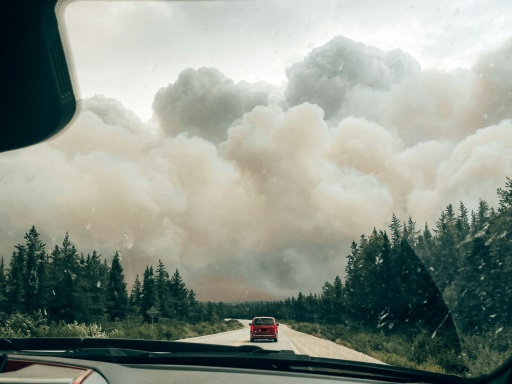In an era of town-torching megablazes spewing smoke plumes visible from space, scientists say there is still a lot they don't know about the effects of extreme fire on people, nature and the climate.
Athens, Maui and now Los Angeles are among major cities across the globe to suffer catastrophic fires, while blazes in Canada's forests have broken records in recent years.
Changes in fire behavior wrought by climate change and other human influences represent "an unprecedented risk that is still very poorly understood", an international group of scientists warned last year in a report for the European Space Agency and FutureEarth.
Human activities, they said, "have become an inexhaustible source of wildfires".
Scientists tallying effects on people and planet are flying planes through smoke belched by raging infernos, scouring satellite images and scooping samples from soils and waterways.
Sometimes the flames come to them.
In late December 2021, Christine Wiedinmyer, a University of Colorado professor specializing in air pollution and fire emissions, was working at home when emergency services rang telling her to leave.
What started as two small fires on the edges of Boulder had become a monster wall of flame in under an hour, whipped by hurricane-force winds over snow-free grassland.
Wiedinmyer found it hard to believe there was a serious risk on that winter's day but the pasture around town was tinder-dry from months of drought and the fire was already bearing down with the force of a blowtorch.
"You could see the smoke plume right behind my house," she told AFP.
Wiedinmyer joined tens of thousands of locals inching out of town in heavy traffic engulfed in churning smoke and flying embers.
The next day it began to snow.
Wiedinmyer returned to a soot-smeared home and questions from neighbors: Were surviving structures contaminated? If so, how could they be safely cleaned?
Fire has played a role in nature for millions of years -- some species thrive on it -- and human history is entwined with the ability to tame it.
But destructive and intense megafires are now increasing, as humans shape a new combustible era that prominent fire historian Stephen Pyne has called the "Pyrocene".
"Fire has been a companion and now it's becoming our worst enemy," he said.
Tinderbox conditions -- a combination of heat, drought and strong winds often called "fire weather" -- are made more common by climate change.
But it is not the only factor.
Lightning, power lines and arson have provided a spark, while damage risk grows as homes and businesses encroach into fire-prone areas.
In some forest regions, decades of overzealous fire prevention have allowed a build-up of flammable vegetation, leading to calls to relearn indigenous fire management techniques.
Intense rainfall -- on the rise as warming alters the water cycle -- may make things worse, spurring plants to grow fast and then dry into kindling.
Research in 2021 linked melting Arctic sea ice to larger wildfires in the western United States.
With warming of two degrees Celsius -- just above the upper limit of the Paris climate deal -- and expected changes in rainfall, wildfires are projected to burn 35 percent more land, the U.N.'s climate expert panel has said.
There are limitations to humans' ability to adapt, said Kirsten Thonicke, of Potsdam Institute for Climate Impact Research, as smoke carries pollution huge distances.
"You cannot evacuate Sydney or San Francisco, you can only try to protect people there," she said, stressing the need to cut planet-heating emissions.
Some fires change the weather.
Firestorm clouds can whip up winds and shoot off lightning bolts, while fire tornados are towering funnels of flame thrashing across the landscape.
And extreme blazes are affecting the environment and atmosphere.
The 2023 Canadian wildfires released more carbon in five months than Russia emitted from fossil fuels in a year, NASA scientists found.
Most of that CO2 is reabsorbed as trees regrow but there are concerns that more frequent fires could reduce forests' capacity to take up carbon.
In 2023, researchers found that a chemical reaction from smoke released by massive wildfires in Australia made 2020's ozone hole 10 percent wider.
Another study found ash from the same fires landed on the ocean, triggering plankton blooms that soaked up the extra CO2, at least temporarily.
Joan Llort, of the Barcelona Supercomputing Center, who led that research, said ash from huge fires was part of "regime change" in the Arctic, coating ice and causing it to melt faster.
What preoccupied Christine Wiedinmyer after Boulder's Marshall Fire was residue in homes.
"There's a lot of nasty stuff that gets put out there when you burn a house or a car, or electronics," she said. "Where does it go?"
Wiedinmyer and colleagues took samples from the air, soils and houses and measured the effects of cleaning.
Early research found harmful smoke compounds were sucked into walls only to leach out days or even months later.
One finding of potential use to residents in LA, where thousands of homes have burned, was that wiping down walls and floors with soap and water reduced contamination.
"That is a really useful piece of information to help guide future people who are exposed," Wiedinmyer said.
© 2025 AFP















16 Comments
Login to comment
wallace
New LA fires and 19,000 people evacuated.
Desert Tortoise
Watching it on an LA news station. There are all kinds of aircraft working including California Air Guard C-130s and what I was amazed to see were bulldozers driving piles of dirt right into the flame front on some really steep ridges. The helicopters will be flying all night. There is a huge reservoir right next to the fire for the helicopters and another five minutes away. But, there are really high winds and that makes it tough. Supposed to get windier later on.
Desert Tortoise
No rain in southern California for almost 300 days. Relative humidity is 2%. Winds gusting to over 30 knots.
wallace
LIVE: Hughes Fire forces evacuations in Castaic
https://www.youtube.com/live/Yk8WG5AOpIw?si=AG1fLkkHFiVUWdDR
virusrex
You made no point, just repeatedly breaking the rules to show you have no respect for them.
Desert Tortoise
They have the fire beat down pretty well. There were 12-18 fixed wing aircraft and at least that many helicopters working the fire during the day and about seven or eight helos with pilots flying on night vision goggles working the fire tonight.
iknowall
This fire has nothing to do with climate change.
Trump told Newsom from the day they first met almost 10 years ago that he must clean his forest floors regardless of what the environmentalists demand of him.
Now DEI misguided policies, and saving a fish instead of storing water combined with woke politics have ruined Southern California.
wallace
The city does not own all the forest floors.
iknowall
Newsom is the governor of the STATE of California.
virusrex
Yes it does, the experts have said clearly that climate change make the fires extreme, what evidence do you have to refute their expert opinions?
iknowall
Nowhere in the article does any quote appear that "climate change make the fires extreme".
Just making up wild claims is not qualified as evidence, and does not change the facts.
Time to move on.
virusrex
Reading the article could have saved from making this terribly wrong claim.
*Changes in fire behavior wrought by climate change and other human influences represent "an unprecedented risk that is still very poorly understood", an international group of scientists warned last year in a report for the European Space Agency and FutureEarth.*
You on the other hand claimed that the fire had nothing to do with climate change, but could not support this claim with anything, much less the content of the article.
Desert Tortoise
There is no forest where these fires are burning. It is scrub oak, chaparral and dry grass. Forests, such as they are in So Cal are at higher elevations and the trees tend to be pretty scrawny and widely spaced. It is arid, even in the mountains so you do not have lush forests like one finds in Oregon, Washington, Idaho or even northern Cal.
The reservoirs in Southern California are all full. There is no shortage of water. What you saw in Pacific Palisades and Altadena was demand for water outstripping the ability of the pipes to deliver. The LA water system works mostly by gravity, fed from a single big reservoir at the high point of the city. It has been that way since 1913. But the demand for water in Pacific Palisades was four times the capacity of the system and that demand persisted for 15 straight hours. Worse, LADWP employees could not access parts of the water system to operate valves to improve the situation or to start auxiliary generators due to those sites being right in the fire zone. There as one dinky little reservoir out of service due to a torn cover. The city was in the process of taking bids to repair the cover. The cover is necessary to keep the water inside clean enough to drink. It cannot be open air.
The current fire in Castaic is right next to a full reservoir. No shortage of water.
As for saving fish, agricultural water diversions have destroyed a once prosperous salmon fishing industry and devastated the economies of some northern Cal coastal towns that once had a profitable salmon fishing and processing industry, along with the boat yards and other businesses that supported that industry. Damming rivers and diverting the water to irrigation has destroyed the entire salmon fishery and with it, the fishing fleets, and workers it supported. That is not a trivial loss. Salmon was once so abundant in the Sacramento and San Joaquin Rivers it was called "poor man's steak". Now fresh caught salmon costs twice as much as most cuts of beef, or more depending on the cut.
Desert Tortoise
So Cal has not had any rain since last Easter. December was dry. No rain yet 23 days into January. That is very far from normal.
bass4funk
Yeah, ok…
https://nypost.com/2025/01/13/us-news/gavin-newsom-cut-fire-budget-while-pouring-billions-into-climate-change-critics/
iknowall
It is normal for places to have droughts and not have fires.
Is it normal for a 117-million gallon reservoir in Los Angeles to be out of commission for so long?
Good you moved on and proved your original statement "climate change make the fires extreme" does not appear in this article and is not attributed to any expert. Anyone knowledgeable about the SoCal fires is aware there was lack of basic care by the State of California with the brush in the forests, the city letting their water supply basically run out, and the cutting of funds so that the firefighting force has been depleted.